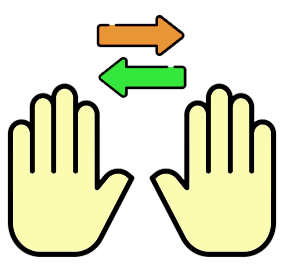Handedness of a child
Left-handedness does not have a simple inheritance model. According to studies of twins and their families, about 25% of left-handedness can be explained by the influence of genes, while the remaining 75% is determined by the influence of the environmental factors.
Handedness

A left-handed person (“leftie”) is a person who prefers to use left hand instead of right. Approximately 10% of the population is left-handed.
Left-handedness, like many other human traits, is influenced by many factors, including genetics and the environment.
Scientists for many years have been trying to find the cause of left-handedness, conducting a lot of research. So far, scientists have come to the conclusion that genetics is responsible for about 25% of left-handedness, and the remaining 75% is the influence of the environment.
In addition, studies show that left-handed people have a slightly higher risk of developing schizophrenia, but a lower risk of Parkinson's disease. There is also speculation that lefties may have better verbal skills.
Most children have a preference for using the right or left hand by about 18 months of age, and by the age of three, you can almost certainly determine that a child is left-handed or right-handed.
Genetics
It was believed that one gene is responsible for left-handedness. However, recent studies suggest that a person becomes left-handed under the influence of about 40 genes. Each of these genes is likely to have minimal influence on its own, but together they play a significant role in the preference of a particular hand.
Left-handedness does not have a simple inheritance model. Children of left-handed parents are more likely to be left-handed than children of right-handed parents. However, since the percentage of left-handed people is quite small compared to right-handed, left-handed parents in most cases will have right-handed children.
The handedness genetic calculator calculates the probability based on statistical data. Although according to some studies, it is possible to find out which hand the child prefers from the 13th week of pregnancy, the environment has a rather large impact, as a result of which, preferences can change. In 18 percent of identical twins one twin is right-handed and the other left-handed.
Genes, Culture, and Health
Beyond genetics and environmental influences, there are cultural and societal factors that shape attitudes toward left-handedness.
Historical representations and modern studies
Throughout history, left-handedness has been associated with various superstitions and cultural beliefs. In some societies, being left-handed was considered taboo or even sinister, leading to efforts to force left-handed individuals to use their right hand instead. These attitudes have thankfully evolved over time, but remnants of bias against left-handedness can still be found in some cultures today.
Interestingly, left-handedness has also been linked to creativity and innovation. Numerous famous artists, musicians, and thinkers throughout history have been left-handed, leading to speculation about a potential connection between handedness and creative abilities. While research on this topic is ongoing, there is evidence to suggest that left-handed individuals may indeed have certain cognitive advantages, such as enhanced divergent thinking skills.
Neurobiological differences and connection with diseases
In addition to its potential links to creativity, left-handedness has been associated with specific neurological differences. Studies using brain imaging techniques have revealed differences in brain structure and function between left-handed and right-handed individuals. These differences may contribute to the observed differences in cognitive abilities and susceptibility to certain neurological conditions.
Furthermore, the relationship between left-handedness and various health conditions continues to be an active area of research. While it's true that left-handed individuals have a slightly higher risk of developing schizophrenia, they also appear to have a lower risk of other neurological disorders such as Parkinson's disease. Understanding the underlying biological mechanisms behind these associations could lead to insights into the pathogenesis of these conditions and potential therapeutic interventions.
Impact on daily life and cultural variations
Another aspect worth considering is the impact of handedness on everyday life. In a world designed primarily for right-handed individuals, left-handed people often encounter challenges in performing simple tasks such as using tools, utensils, or even writing. These challenges can lead to adaptations and strategies unique to left-handed individuals, shaping their experiences and perceptions of the world around them.
Moreover, the prevalence of left-handedness varies across different populations and demographic groups. While approximately 10% of the global population is left-handed, this percentage can vary significantly depending on factors such as culture, ethnicity, and socioeconomic status. Understanding these variations can provide valuable insights into the complex interplay of genetic and environmental influences on handedness.
In recent years, advances in genetic research have provided unprecedented insights into the complex genetic basis of left-handedness. While it was once thought that a single gene determined hand preference, we now know that multiple genes interact to influence this trait. However, the precise mechanisms by which these genes influence handedness are still not fully understood, and further research is needed to unravel this complexity.
In conclusion, left-handedness is a fascinating phenomenon that encompasses genetic, environmental, cultural, and neurological factors. While significant progress has been made in understanding the underlying mechanisms of handedness, many questions remain unanswered. Continued research in this field promises to shed further light on the intricacies of human brain development, cognition, and behavior.